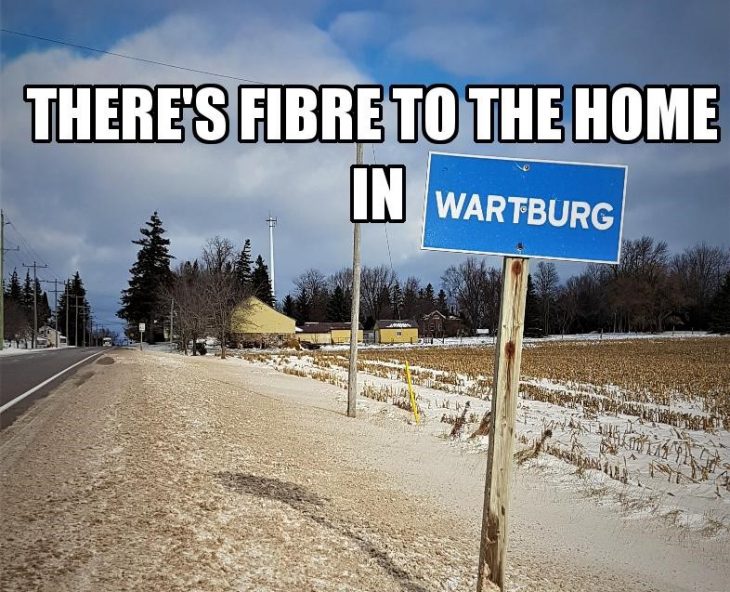
WHATEVER THE CRTC says Wednesday are to be the new basic service obligations for Canadian telcos and ISPs, Quadro Communications is more than ready. It might well be the Canadian incumbent carrier which will have the least trouble adapting to the new rules.
The 3,100-member telecom co-op headquartered in Kirkton, Ont., has already deployed fibre to the home to every farmhouse, barn and business in its four exchanges which sit in in parts of Perth, Huron, Middlesex and Oxford counties in southwestern Ontario farm country about 45 kms north of London, Ont.
That’s right, the folks living in places like Wartburg (pictured above), Woodham, and Sebringville have had access to Gigabit internet since the summer when the company completed an eight-year, $20-million fibre build. It wasn’t just to new, greenfield areas or to its more densely populated areas. Quadro has built fibre to everyone down every single county road in its territory.
“If you’re within our exchanges, every farm, every home, every business, every premise where there’s a telephone,” is now on its active fibre network, right through the last mile, general manager John DeHeer said in an interview in Kirkton last month. In fact, with a dedicated fibre from nearby St. Mary’s to the Torix internet exchange in Toronto, Quadro customers may have the cleanest, fastest broadband in the country. “There are no bumps and jumps to secondary providers or whatever,” he added.
But, why give everyone fibre to their homes when most other carriers, especially the big ones, would look down some of these lonely county roads and say they would never try to afford FTTH in such regions (In fact some did say exactly that during the basic services obligation hearing – for which the CRTC will announce its decision Wednesday – explaining the only way for such sparsely populated regions to get broadband will likely be wirelessly)? Why not take the money and expand as a competitor into other more densely populated centres in search of a fatter payoff?
The simple answer is that it was the fairest decision.
“There are areas and there are roads that make no economic sense to run the cable except there was a promise to all of our members to do it.” – John Alderman, Quadro Communications
“We decided that the co-op members all deserve the same service,” added Quadro board chair John Alderman, during the same visit. “We shouldn't just take the most economic ones and say, ‘Oh, we could make more money if we put fibre into this town, meanwhile you don't get any at your place because we can't make as much money doing it.’ We decided when the promise, as we call it, is finished to all of the original members, then we will look beyond our boundaries.
“There are areas and there are roads that make no economic sense to run the cable except there was a promise to all of our members to do it,” he said.
The company, as its name might suggest, offers a full quad-play to its customers: voice, broadband and TV (including HD DVR options and a TV Everywhere solution) – as well as wireless as a Bell Mobility reseller. It offers various broadband packages ranging in speeds from 15 Mbps download for $55/month to its 1 Gbps package for $300/month. No packages have data caps nor does the company charge additonal modem rental fees.
Quadro’s history, like other independent telcos in southwestern Ontario which we will examine in the coming weeks, dates back more than 100 years. The co-op converted from the Blanshard Municipal Telephone System which served Sebringville, Granton, Kirkton and Uniondale.
Each customer in its traditional exchanges (a map of which is pictured, with Alderman on the left and DeHeer on the right) is a co-op member for $1 and they each get a vote on how the co-op operates. They also elect a 
The company is also a CLEC in a few regions at its edges and it co-owns Mitchell-Seaforth Cable TV with fellow independent co-ops Hay Communications (Zurich, Ont.) and Tuckersmith Communications (Kippen, Ont.). The three companies purchased the cable company in 2009 which serves communities such as Mitchell, Lucan and Dublin – and each of their IPTV digital TV systems are fed by the cableco.
One of the toughest things for the 30-employee company to explain to people in the region is the old exchange system which binds them as an ILEC to those areas. Since Quadro is an incumbent in its four exchanges and has built fibre essentially to those limits (except for a few more densely populated villages like Bryanston) it often has to apologize to folks on some of these county roads whose homes fall just outside their territory meaning while one neighbour has access to fibre-based broadband, the next farmhouse over has to rely on far slower fixed wireless or satellite or ancient DSL.
Looking at the exchange map, DeHeer and Alderman would like to “square off” some of the odd gaps built into the local exchanges so that some neighbours could have equal services, but running fibre – even just a little farther to that next barn – is expensive, anywhere from $10,000 to $20,000 a kilometre, depending on river or railway crossings and other challenges for the all-underground fibre network.
As a rural business, Quadro faces certain demographic challenges, too, that urban operators do not. The era of the 100 to 500 acre farmer has ended and as farms get ever larger, the number of customers gets smaller. “When they buy another farm, they bulldoze the house down,” said Alderman of those who stay and decide to grow their farms.
“On the other hand, the guys that are left have about the highest tech demands,” he noted.
“They want to be connected,” adds DeHeer. “When they're traveling, they want to be able to look in the barn and see what's going on. They get their alarms through the mobile network or through the internet. They can see the barns which all have cameras in them… and we provide this pipe for them… Some of them have four routers upstairs in the barn to make sure they can collect all the data. The people in the barn are keeping track of all the animals on a handheld device, programming it. It's phenomenal.”
“The kids come to visit me because the internet is faster at grandpa's place than it is where I live in the city.” – Alderman
And in some cases, having fibre pays off in other ways. “I had one farmer say, ‘The kids come to visit me because the internet is faster at grandpa's place than it is where I live in the city’,” said Alderman.
Some of Quadro’s areas are also bedroom communities for nearby London (pop. 366,000), with people who are happy to know they can live in the country with fibre broadband.
What does get frustrating for companies like Quadro is the fact that so few outside of their regions know how progressive the company is – and how fortunate their customers are – or when others assume that because a  place like Woodham is such a small dot on the map that it can’t possibly have reliable broadband.
place like Woodham is such a small dot on the map that it can’t possibly have reliable broadband.
“We had a professor from the University of Western Ontario talking on CBC radio, who kept using Whalen's Corner, which is just down the road here, the other side of Woodham, as an example,” DeHeer recalled. “He mentioned his grandparents saying ‘Oh, my grandparents live out of Waylan's Corner, do you think they have fiber?’ Actually I'm in the car yelling onto the radio: They freaking do!”
Both DeHeer and Alderman said at several points in our interview that Quadro’s customers, while mostly small-town rural, still want and need the same broadband advantages as in the big cities.
The thing is, though, with the big telcos still needing several years to overbuild only their most populous regions with fibre – and with cable companies still some months or years away from the Gigabit speeds promised by DOCSIS 3.1, Quadro customers may actually have it best of all.
EDITOR’S NOTE: This is the first in what will be an ongoing series which will continue through 2017 where Cartt.ca will examine the many independent service providers offering connectivity to Canadians in rural or small-town settings: how they operate, their strategies for growth, their challenges, frustrations, and successes – and whether or not government is a hindrance or a help (or both). There are independents of various sizes from coast to coast to coast serving approximately a million Canadians and we've been talking to them. Their economics and demographics are different but – as in the case of Quadro above – their choices can greatly benefit their customers. Please contact us at editorial@cartt.ca if you would like to tell us a story about an independent operator.




